Discover 35 hidden attractions, cool sights, and unusual things to do in Cardiff (United Kingdom). Don't miss out on these must-see attractions: National Museum Cardiff, St Fagans National History Museum, and Queen Street. Also, be sure to include Cardiff Castle in your itinerary.
Below, you can find the list of the most amazing places you should visit in Cardiff (Wales).
Table of Contents
National Museum Cardiff
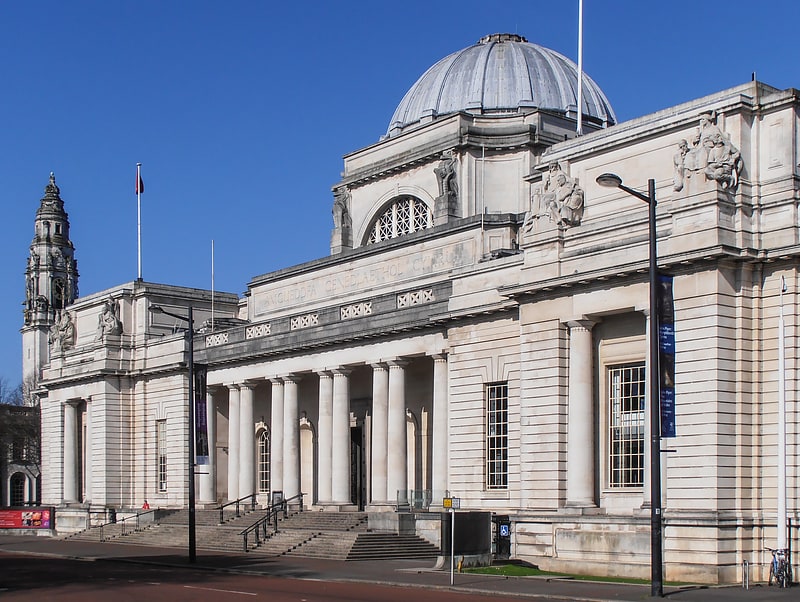
Art and Welsh history in a grand setting. National Museum Cardiff is a museum and art gallery in Cardiff, Wales. The museum is part of the wider network of Amgueddfa Cymru – National Museum Wales. Entry is kept free by a grant from the Welsh Government; however, they do ask for donations throughout the museum.[1]
Address: Cathays Park, CF10 3NP Cardiff (Canol Dinas Caerdydd)
St Fagans National History Museum
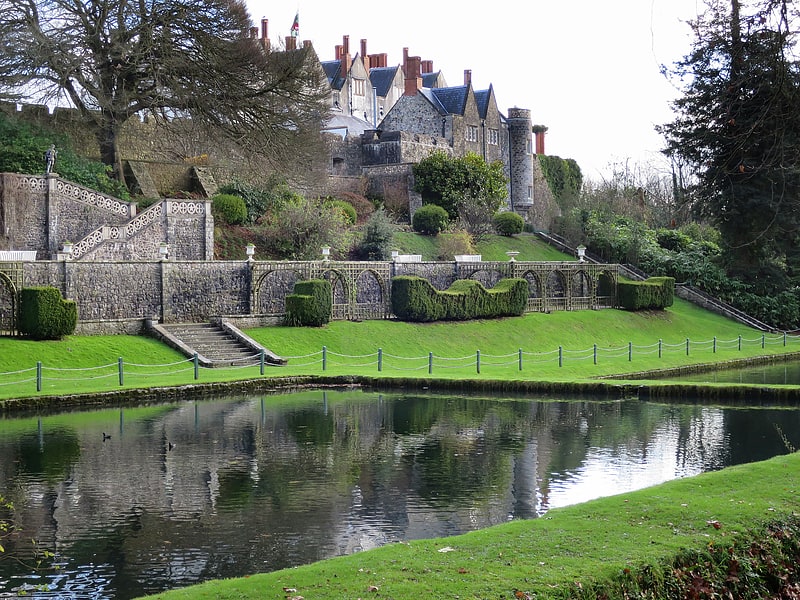
Museum in Cardiff, Wales. St Fagans National Museum of History, commonly referred to as St Fagans after the village where it is located, is an open-air museum in Cardiff chronicling the historical lifestyle, culture, and architecture of the Welsh people. The museum is part of the wider network of Amgueddfa Cymru – National Museum Wales.
It consists of more than forty re-erected buildings from various locations in Wales, and is set in the grounds of St Fagans Castle, a Grade I listed Elizabethan manor house. In 2011 Which? magazine named the museum the United Kingdom's favourite visitor attraction.
A six-year, £30-million revamp was completed in 2018 and the museum was named the Art Fund Museum of the Year in 2019.[2]
Address: Michaelston Rd, CF5 6XB Saint Fagans (Gorllewin Caerdydd)
Queen Street
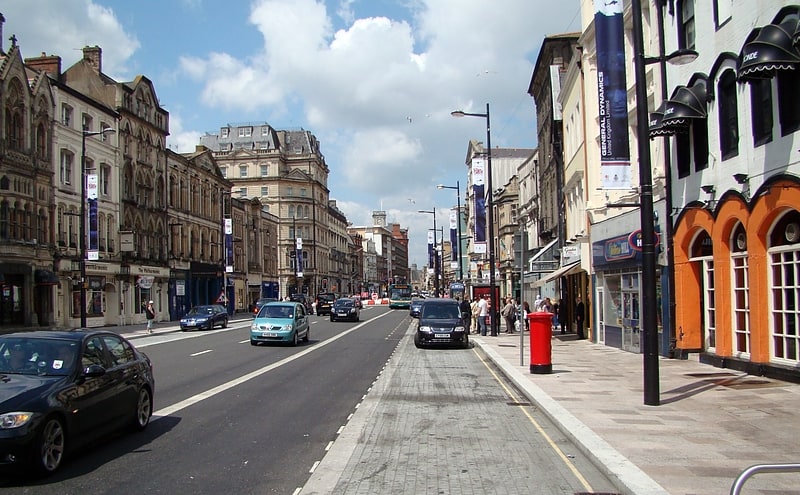
Street in Cardiff, Wales. St Mary Street and High Street are major commercial streets in the Castle Quarter of Cardiff city centre, Wales, which form a major thoroughfare running south from the gatehouse of Cardiff Castle. High Street begins at the junction of Castle Street on the A4161 and ends at the junction of Church Street and Quay Street, from where St Mary Street begins until the roundabout at Callaghan Square on the A4160.[3]
Address: Queen St, CF10 Cardiff (Canol Dinas Caerdydd)
Cardiff Castle
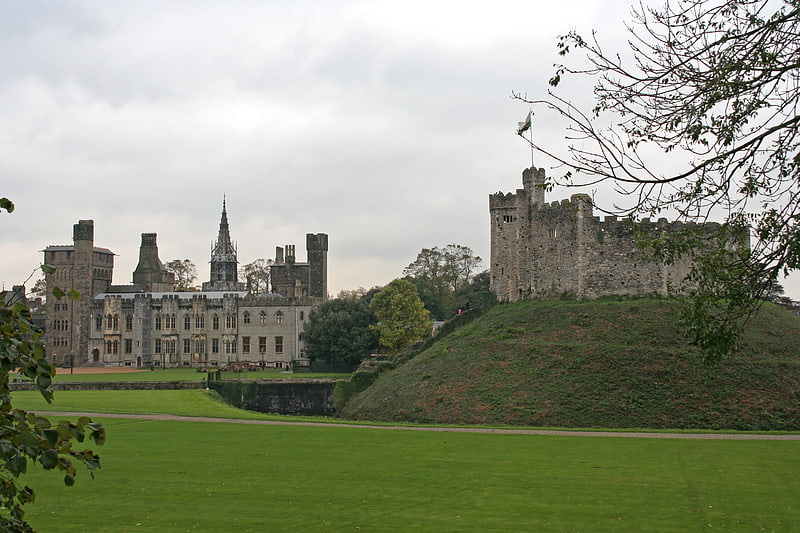
Gothic castle with extravagant interior. Cardiff Castle is a medieval castle and Victorian Gothic revival mansion located in the city centre of Cardiff, Wales. The original motte and bailey castle was built in the late 11th century by Norman invaders on top of a 3rd-century Roman fort. The castle was commissioned either by William the Conqueror or by Robert Fitzhamon, and formed the heart of the medieval town of Cardiff and the Marcher Lord territory of Glamorgan. In the 12th century the castle began to be rebuilt in stone, probably by Robert of Gloucester, with a shell keep and substantial defensive walls being erected. Further work was conducted by the 6th Earl of Gloucester in the second half of the 13th century. Cardiff Castle was repeatedly involved in the conflicts between the Anglo-Normans and the Welsh, being attacked several times in the 12th century, and stormed in 1404 during the revolt of Owain Glyndŵr.
After being held by the de Clare and Despenser families for several centuries, the castle was acquired by The 13th Earl of Warwick and Comte de Aumale in 1423. Lord Warwick conducted extensive work on the castle, founding the main range on the west side of the castle, dominated by a tall octagonal tower. Following the Wars of the Roses, the status of the castle as a Marcher territory was revoked and its military significance began to decline. The Herbert family took over the property in 1550, remodelling parts of the main range and carrying out construction work in the outer bailey, then occupied by Cardiff's Shire Hall and other buildings. During the English Civil War Cardiff Castle was initially taken by a Parliamentary force, but was regained by Royalist supporters in 1645. When fighting broke out again in 1648, a Royalist army attacked Cardiff in a bid to regain the castle, leading to the Battle of St Fagans just outside the city. Cardiff Castle escaped potential destruction by Parliament after the war and was instead garrisoned, probably to protect against a possible Scottish invasion.
In the mid-18th century, Cardiff Castle passed into the hands of the Stuart dynasty, Marquesses of Bute. John, 1st Marquess of Bute, employed Capability Brown and Henry Holland to renovate the main range, turning it into a Georgian mansion, and to landscape the castle grounds, demolishing many of the older medieval buildings and walls. During the first half of the 19th century the family became extremely wealthy as a result of the growth of the coal industry in Glamorgan. However, it was the 3rd Marquess of Bute who truly transformed the castle, using his vast wealth to back an extensive programme of renovations under William Burges. Burges remodelled the castle in a Gothic revival style, lavishing money and attention on the main range. The resulting interior designs are considered to be amongst "the most magnificent that the gothic revival ever achieved". The grounds were re-landscaped and, following the discovery of the old Roman remains, reconstructed walls and a gatehouse in a Roman style were incorporated into the castle design. Extensive landscaped parks were built around the outside of the castle.
In the early 20th century, the 4th Marquess of Bute inherited the castle and construction work continued into the 1920s. The Bute lands and commercial interests around Cardiff were sold off or nationalised until, by the time of the Second World War, little was left except the castle. During the war, extensive air raid shelters were built in the castle walls; they could hold up to 1,800 people. When the 4th Marquess died in 1947, the castle was given to the City of Cardiff. Today the castle is run as a tourist attraction, with the grounds housing the "Firing Line" regimental museum and interpretation centre. The castle has also served as a venue for events, including musical performances and festivals.[4]
Address: 5 Duke St, CF10 1AY Cardiff (Canol Dinas Caerdydd)
Castell Coch
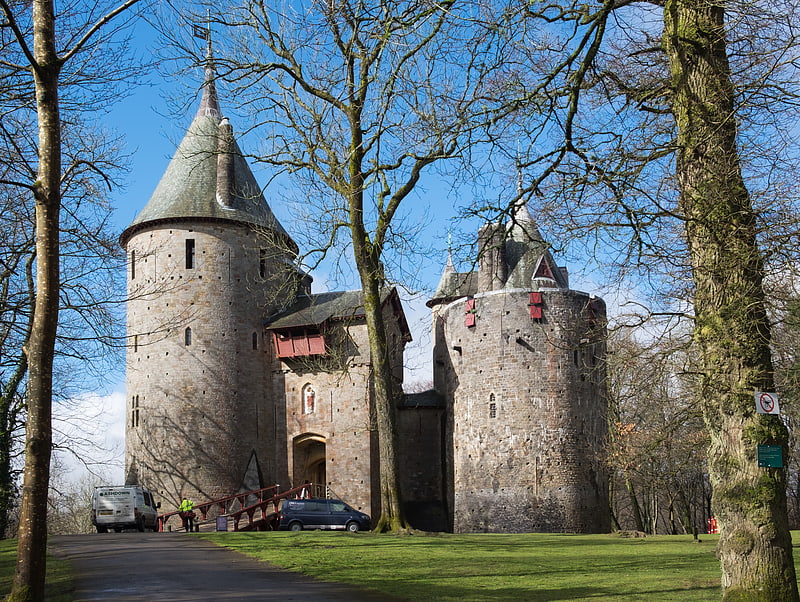
Stately 1800s castle . Castell Coch is a 19th-century Gothic Revival castle built above the village of Tongwynlais in South Wales. The first castle on the site was built by the Normans after 1081 to protect the newly conquered town of Cardiff and control the route along the Taff Gorge. Abandoned shortly afterwards, the castle's earth motte was reused by Gilbert de Clare as the basis for a new stone fortification, which he built between 1267 and 1277 to control his freshly annexed Welsh lands. This castle may have been destroyed in the native Welsh rebellion of 1314. In 1760, the castle ruins were acquired by John Stuart, 3rd Earl of Bute, as part of a marriage settlement that brought the family vast estates in South Wales.
John Crichton-Stuart, 3rd Marquess of Bute, inherited the castle in 1848. One of Britain's wealthiest men, with interests in architecture and antiquarian studies, he employed the architect William Burges to rebuild the castle, "as a country residence for occasional occupation in the summer", using the medieval remains as a basis for the design. Burges rebuilt the outside of the castle between 1875 and 1879, before turning to the interior; he died in 1881 and the work was finished by Burges's remaining team in 1891. Bute reintroduced commercial viticulture into Britain, planting a vineyard just below the castle, and wine production continued until the First World War. He made little use of his new retreat, and in 1950 his grandson, the 5th Marquess of Bute, placed it into the care of the state. It is now controlled by the Welsh heritage agency Cadw.
Castell Coch's external features and the High Victorian interiors led the historian David McLees to describe it as "one of the greatest Victorian triumphs of architectural composition." The exterior, based on 19th-century studies by the antiquarian George Clark, is relatively authentic in style, although its three stone towers were adapted by Burges to present a dramatic silhouette, closer in design to mainland European castles such as Chillon than native British fortifications. The interiors were elaborately decorated, with specially designed furniture and fittings; the designs include extensive use of symbolism drawing on classical and legendary themes. Joseph Mordaunt Crook wrote that the castle represented "the learned dream world of a great patron and his favourite architect, recreating from a heap of rubble a fairy-tale castle which seems almost to have materialised from the margins of a medieval manuscript."
The surrounding Castell Coch beech woods contain rare plant species and unusual geological features and are protected as a Site of Special Scientific Interest.[5]
Address: Castle Road, CF15 7JQ Tongwynlais (Gogledd Caerdydd)
Bute Park
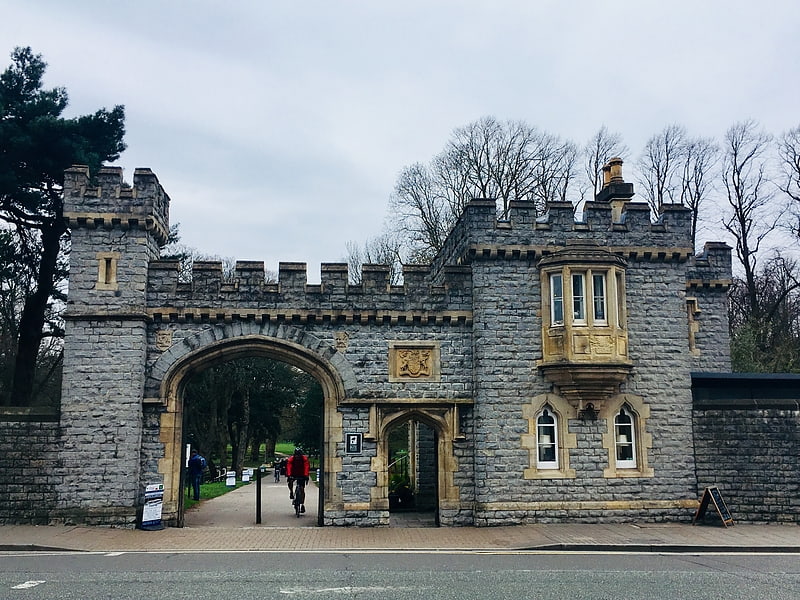
City park in Cardiff, Wales. Bute Park or its full name Bute Park and Arboretum, is a major park in the city of Cardiff, capital of Wales. It comprises 130 acres of landscaped gardens and parkland that once formed the grounds of Cardiff Castle. The park is named after the 3rd Marquess of Bute, whose family owned the castle.[6]
Address: Castle St, CF10 3DX Cardiff (Canol Dinas Caerdydd)
Wales Millennium Centre

Opera in Cardiff, Wales. Wales Millennium Centre is an arts centre located in the Cardiff Bay area of Cardiff, Wales. The site covers a total area of 4.7 acres. Phase 1 of the building was opened during the weekend of the 26–28 November 2004 and phase 2 opened on 22 January 2009 with an inaugural concert. The centre has hosted performances of opera, ballet, contemporary dance, theatre comedy, pop stars, and musicals.
The Wales Millennium Centre comprises one large theatre and two smaller halls with shops, bars and restaurants. It houses the national orchestra and opera, dance, theatre and literature companies, a total of eight arts organisations in residence.
The main theatre, the Donald Gordon Theatre, has 2,497 seats, the BBC Hoddinott Hall 350 and the Weston Studio Theatre 250.
In 2001 Lord Rowe-Beddoe was appointed chairman of Wales Millennium Centre, a company limited by guarantee. Board members include Sir Michael Checkland.[7]
Address: Bute Pl, CF10 5AL Cardiff (Caerdydd Wouth)
Millennium Stadium
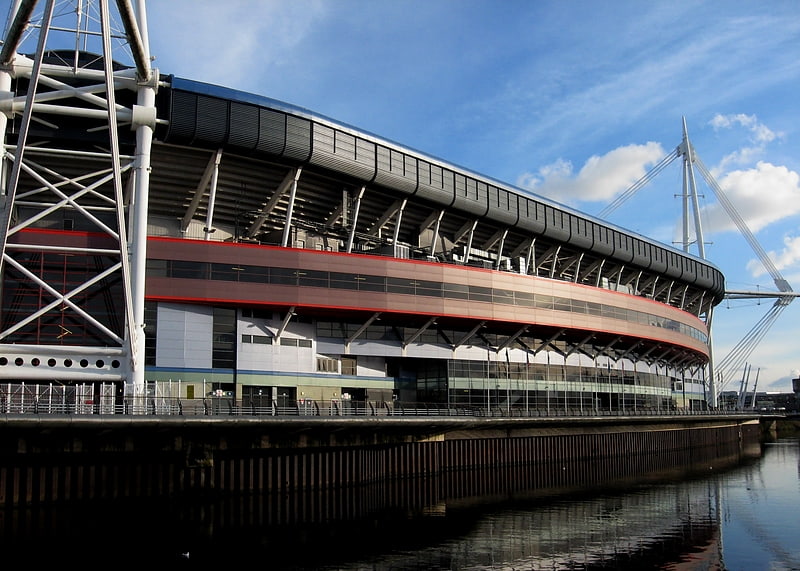
World-class sports arena and concert venue. The Millennium Stadium, known since 2016 as the Principality Stadium for sponsorship reasons, is the national stadium of Wales. Located in Cardiff, it is the home of the Wales national rugby union team and has also held Wales national football team games. Initially built to host the 1999 Rugby World Cup, it has gone on to host many other large-scale events, such as the Tsunami Relief Cardiff concert, the Super Special Stage of Wales Rally Great Britain, the Speedway Grand Prix of Great Britain and various concerts. It also hosted FA Cup, League Cup and Football League play-off finals while Wembley Stadium was being redeveloped between 2001 and 2006, as well as football matches during the 2012 Summer Olympics.
The stadium is owned by Millennium Stadium plc, a subsidiary company of the Welsh Rugby Union (WRU). The architects were Bligh Lobb Sports Architecture. The structural engineers were WS Atkins and the building contractor was Laing. The total construction cost of the stadium was £121 million, of which the Millennium Commission funded £46 million.
The Millennium Stadium opened in June 1999 and its first major event was an international rugby union match on 26 June 1999, when Wales beat South Africa in a test match by 29–19 before a crowd of 29,000. With a total seating capacity of 73,931, it is the largest stadium in Wales and the fourth largest (and second largest outside London) in the United Kingdom by total capacity. In addition, it is the third-largest stadium in the Six Nations Championship behind the Stade de France and Twickenham. It is also the second-largest stadium in the world with a fully retractable roof and was the second stadium in Europe to have this feature. Listed as a category four stadium by UEFA, the stadium was chosen as the venue for the 2017 UEFA Champions League Final, which took place on 3 June 2017. In 2015, the Welsh Rugby Union announced a 10-year sponsorship deal with the Principality Building Society that saw the stadium renamed as the "Principality Stadium" from early 2016.[8]
Address: Westgate St, CF10 1NS Cardiff (Canol Dinas Caerdydd)
Cathays Park

Cathays Park or Cardiff Civic Centre is a civic centre area in the city centre of Cardiff, the capital city of Wales, consisting of a number of early 20th century buildings and a central park area, Alexandra Gardens. It includes Edwardian buildings such as the Temple of Peace, City Hall, the National Museum and Gallery of Wales and several buildings belonging to the Cardiff University campus. It also includes Cardiff Crown Court, the administrative headquarters of the Welsh Government, and the more modern Cardiff Central police station. The Pevsner architectural guide to the historic county of Glamorgan judges Cathays Park to be "the finest civic centre in the British Isles". The area falls within the Cathays electoral ward.[9]
Address: Museum Avenue, CF10 3AX Cardiff (Canol Dinas Caerdydd)
Pierhead Building
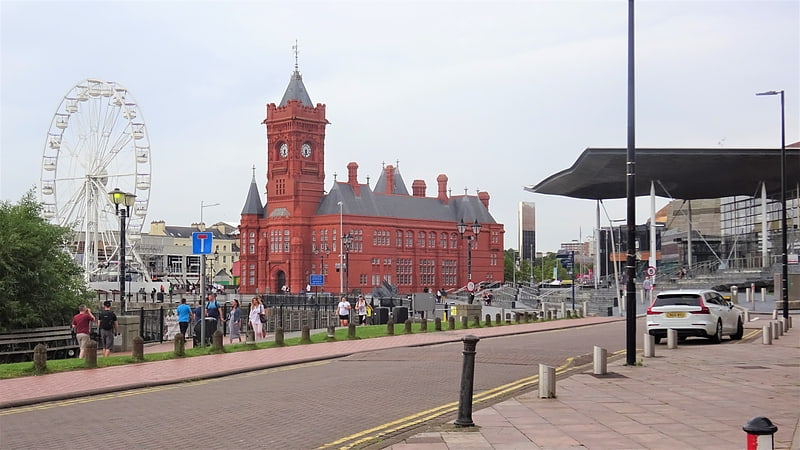
Building in Cardiff, Wales. The Pierhead Building is a Grade I listed building in Cardiff Bay, Wales. One of Cardiff's most familiar landmarks, it was built in 1897 as the headquarters for the Bute Dock Company.
The Pierhead Building is part of the estate of the Senedd (Welsh Parliament; Welsh: Senedd Cymru), which also includes the Senedd building and Tŷ Hywel. The clock on the building is unofficially known as the "Baby Big Ben" or the "Big Ben of Wales".[10]
Address: Pierhead Building Maritime Road, CF10 4PZ Cardiff (Caerdydd Wouth)
Work of William Burges at Cardiff Castle

From 1865 until his death in 1881 the Victorian architect William Burges undertook the reconstruction of Cardiff Castle for his patron, John Crichton-Stuart, 3rd Marquess of Bute. The rebuilding saw the creation of some of the most significant Victorian interiors in Britain.[11]
St Fagans Castle
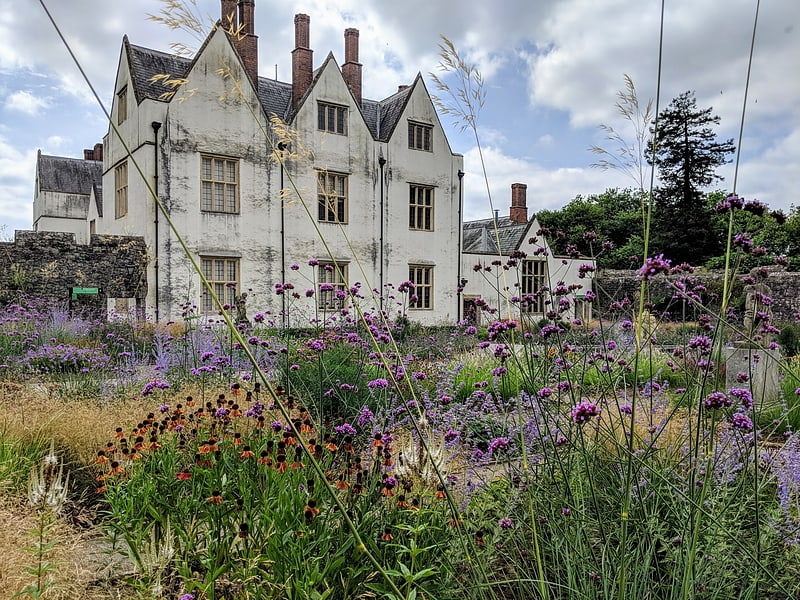
Manor house in Cardiff, Wales. St Fagans Castle is an Elizabethan mansion in St Fagans, Cardiff, Wales, dating from the late 16th century. The house and remaining medieval fortifications are Grade I listed. The grounds of St Fagans Castle now contain St Fagans National Museum of History.[12]
Cardiff Market
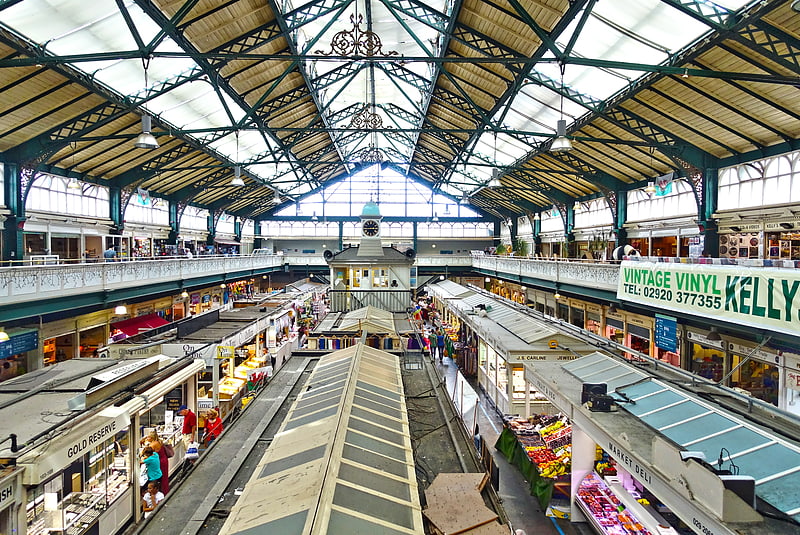
Market in Cardiff, Wales. Cardiff Market, also known as Cardiff Central Market and as the Market Building, is a Victorian indoor market in the Castle Quarter of Cardiff city centre, capital city of Wales.[13]
Address: St Mary St, CF10 1AU Cardiff (Canol Dinas Caerdydd)
Animal Wall
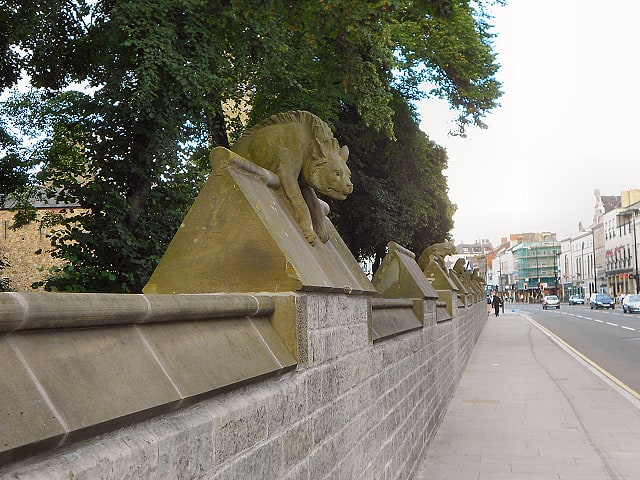
Historical landmark in Cardiff, Wales. The Animal Wall is a sculptured wall depicting 15 animals in the Castle Quarter of the city centre of Cardiff, Wales. It stands to the west of the entrance to Cardiff Castle, having been moved from its original position in front of the castle in the early 1930s. The design for the wall was conceived by William Burges, architect to the third Marquess of Bute, during Burges's reconstruction of the castle in the 1860s, but it was not executed until the late 1880s/early 1890s. This work, which included the original nine animal sculptures, all undertaken by Burges's favourite sculptor, Thomas Nicholls, was carried out under the direction of William Frame, who had previously assisted Burges at both Cardiff Castle and at Castell Coch. When the wall was moved in the early 20th century, the fourth Marquess commissioned Alexander Carrick to carve a further six sculptures to sit on the extended wall which now fronted Bute Park. The Animal Wall is a Grade I listed structure.[14]
Address: Castle Street, Cardiff (Canol Dinas Caerdydd)
Llandaff Cathedral
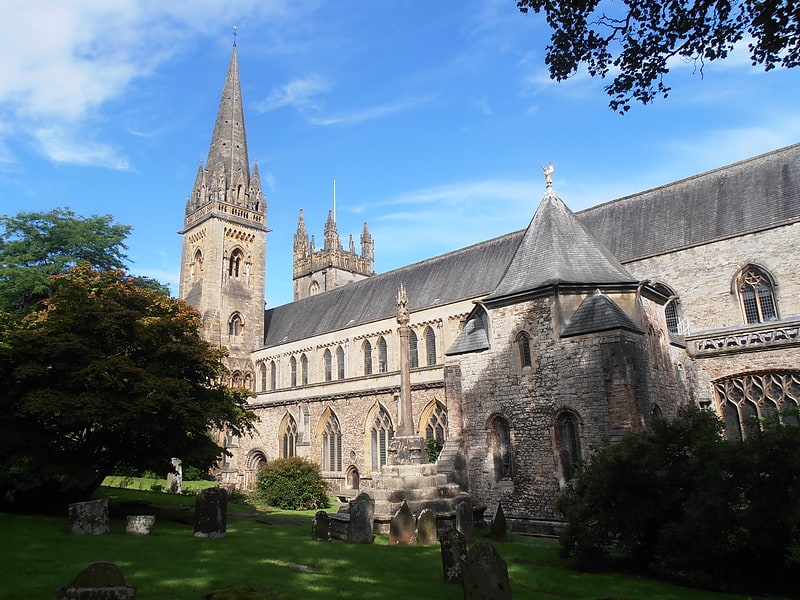
A 13th-century facade and Rossetti artwork. Llandaff Cathedral is an Anglican cathedral and parish church in Llandaff, Cardiff, Wales. It is the seat of the Bishop of Llandaff, head of the Church in Wales Diocese of Llandaff. It is dedicated to Saint Peter and Saint Paul, and three Welsh saints: Dubricius, Teilo and Oudoceus. It is one of two cathedrals in Cardiff, the other being the Roman Catholic Cardiff Metropolitan Cathedral in the city centre.
The current building was constructed in the 12th century on the site of an earlier church. Severe damage was done to the church in 1400 during the rebellion of Owain Glyndŵr, during the English Civil War when it was overrun by Parliamentarian troops, and during the Great Storm of 1703. By 1717, the damage to the cathedral was so extensive that the church seriously considered the removal of the see. Following further storms in the early 1720s, construction of a new cathedral began in 1734, designed by John Wood, the Elder. During the Cardiff Blitz of the Second World War in January 1941, the cathedral was severely damaged when a parachute mine was dropped; blowing the roof off the nave, south aisle and chapter house. The stonework which remains from the medieval period is primarily Somerset Dundry stone, though local blue lias constitutes most of the stonework done in the post-Reformation period. The work done on the church since World War II is primarily concrete and Pennant sandstone, and the roofs, of Welsh slate and lead, were added during the post-war rebuilding. In February 2007, the organ was damaged during a severe lightning strike, prompting a fundraiser of £1.5 million to raise money for an entirely new organ.
For many years, the cathedral had the traditional Anglican choir of boys and men, and more recently a girls' choir, with the only dedicated choir school in the Church in Wales, the Cathedral School, Llandaff. The cathedral contains a number of notable tombs, including Dubricius, a 6th-century British saint who evangelised Ergyng (now Archenfield) and much of South-East Wales, Meurig ap Tewdrig, King of Gwent, Teilo, a 6th-century Welsh clergyman, church founder and saint, and many Bishops of Llandaff, from the 7th century Oudoceus to the 19th century Alfred Ollivant, who was bishop from 1849 to 1882.[15]
Address: Cathedral Cl., CF5 Cardiff (Gorllewin Caerdydd)
Norwegian Church Arts Centre
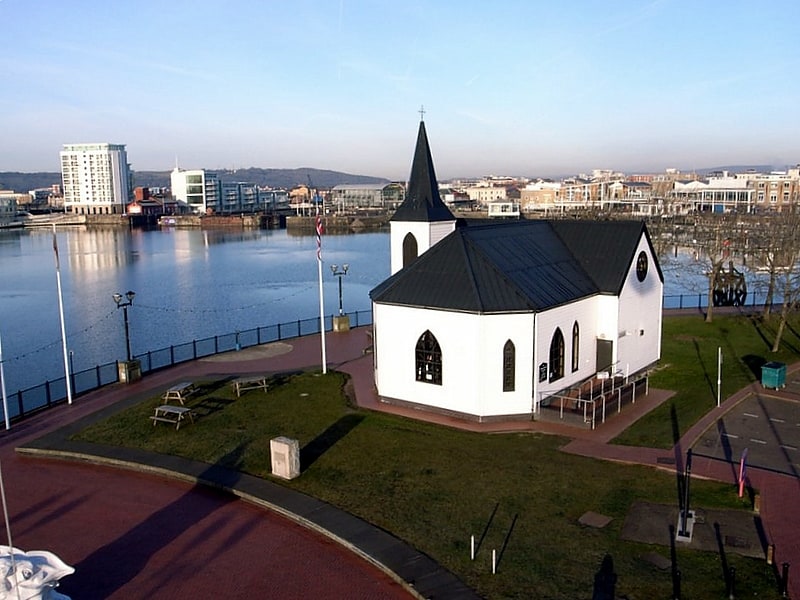
Art center in Cardiff, Wales. The Norwegian Church Arts Centre is a point of cultural and historical interest located in Cardiff Bay, Wales. It was a Lutheran Church, consecrated in 1868. Under the patronage of The Norwegian Seamen's Mission provided home comforts, communication with family and a place of worship for Scandinavian sailors and the Norwegian community in Cardiff for over a hundred years.[16]
Address: Harbour Dr, CF1 0 4 Cardiff (Caerdydd Wouth)
Roath Park

City park in Cardiff, Wales. Roath Park Cardiff, Wales, is one of Cardiff's most popular parks, owned by Cardiff County Council and managed by the Parks Section. It retains a classic Victorian atmosphere and has many facilities. The park has recently been awarded the prestigious Green Flag award to recognise its high quality and its importance to Cardiff. Roath Park has widely diverse environments across the park.
The park was built on 130 acres of reformed bogland, known then as a malarial bog, and includes a 30-acre lake 1.3 miles around, formed by the damming of the Nant Fawr stream. It is a popular facility for fishing and rowing.
There are four islands within a conservation area, home to many water birds. The main park includes a large playground, floral displays, the glasshouse conservatory and recreational areas.
Roath park occupies a long strip of land stretching from Cyncoed in the north to Roath towards the southeast. The park is divided into several parts along the Roath Brook. From north to south, these divisions are: Wild Gardens, Roath Park Lake, Botanical Gardens, Rose Gardens, Pleasure Gardens, Roath Park Recreation Ground, Roath Brook Gardens, Roath Mill Gardens, Waterloo Gardens and the Sandies Open Space.
Two volunteer ‘Friends’ groups work with Cardiff Council to cover the full extent of the historic Roath Park. The Friends of Roath Park serve the northern section of the park as far as Penylan Hill. The south-eastern section of the park is served by the Friends of Penylan’s Gardens.[17]
Address: Lake Road East, Cardiff (Gogledd Caerdydd)
Roald Dahl Plass
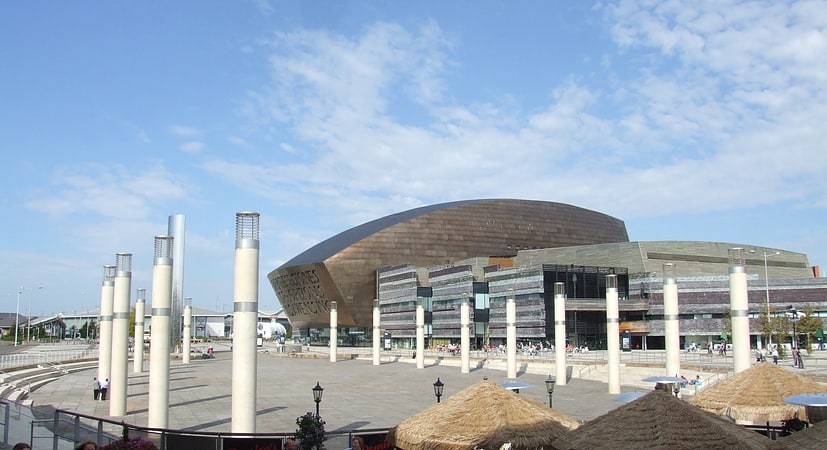
Public plaza named for local author. Roald Dahl Plass is a public space in Cardiff Bay, Cardiff, Wales. It is named after Cardiff-born author Roald Dahl, and is located on the coast along the south of the city centre. The square is home to the Senedd building housing the Senedd, the Welsh parliament, and the Wales Millennium Centre, a performing arts centre. The bowl-like shape of the space has made it a popular amphitheatre for hosting open-air concerts.
Formerly named the Oval Basin and known as the Bowl, the area was one of the docks for a thriving coal port during the latter half the 19th century and much of the 20th century. Following World War II, the space entered a period of decay and dereliction until the 1980s, when the Cardiff Bay area was regenerated.
The name is a nod to the writer's roots (both of Dahl's parents were from Norway) and to the Norwegian seafarers' church which stands nearby. "Plass" is the Norwegian cognate of the English word "place;" in this context the word means square in Norwegian, although the word can also mean "space" or "place." However, in Norwegian the name of a square named after a person would correctly be written in the genitive case, in this case as "Roald Dahls plass" (literally, "Roald Dahl's square"). The word "plass" is not capitalized in modern (post-1907) Norwegian.[18]
Address: Cilgant Bute, CF10 4DQ Cardiff (Caerdydd Wouth)
Senedd

Building in Cardiff, Wales. The Senedd, officially known as the Welsh Parliament in English and Senedd Cymru in Welsh, is the devolved, unicameral legislature of Wales. A democratically elected body, it makes laws for Wales, agrees certain taxes and scrutinises the Welsh Government. It is a bilingual institution, with both Welsh and English being the official languages of its business. From its creation in May 1999 until May 2020, the Senedd was known as the National Assembly for Wales.
The Senedd comprises 60 members who are known as Members of the Senedd (Welsh: Aelodau o'r Senedd), abbreviated as "MS" (Welsh: AS). Since 2011, members are elected for a five-year term of office under an additional member system, in which 40 MSs represent smaller geographical divisions known as "constituencies" and are elected by first-past-the-post voting, and 20 MSs represent five "electoral regions" using the D'Hondt method of proportional representation. Typically, the largest party in the Senedd forms the Welsh Government.
A National Assembly for Wales was created by the Government of Wales Act 1998, following the result of the 1997 referendum. The Assembly initially had no powers to make primary legislation. Limited law-making powers were gained through the Government of Wales Act 2006. Its primary law-making powers were enhanced following a Yes vote in the referendum on 3 March 2011, meaning that the UK Parliament or the Secretary of State for Wales were no longer consulted when passing acts of the National Assembly for Wales related to the 20 devolved areas. These powers were further extended by the Wales Act 2014 and Wales Act 2017, with the latter moving the Assembly to a reserved powers model of devolution like that of the Scottish Parliament. In May 2020, the Assembly was renamed to "Senedd Cymru" or "the Welsh Parliament" when section 2 of the Senedd and Elections (Wales) Act 2020 came into force. Matters devolved to the Senedd include health, education, economic development, transport, the environment, agriculture, local government and some taxes.[19]
Address: Cardiff, National Assembly, Cardiff. CF99 1NA
St John the Baptist Church
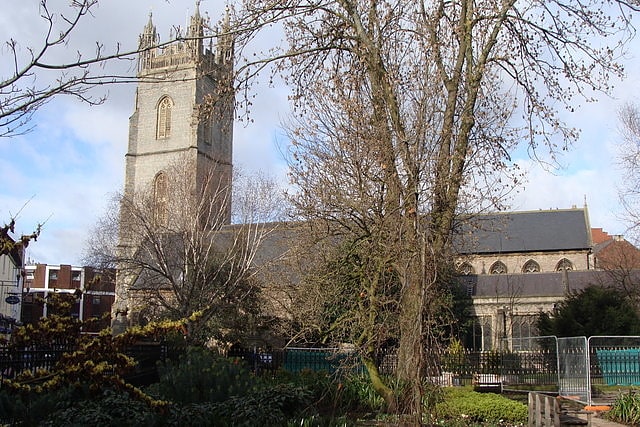
Building in Cardiff, Wales. St John the Baptist Church is a Grade I listed parish church in Cardiff, Wales, the only church dating to pre-Medieval times in Cardiff city centre and the only medieval building other than Cardiff Castle.[20]
Address: St. John Street, CF10 1GL Cardiff (Canol Dinas Caerdydd)
City Hall
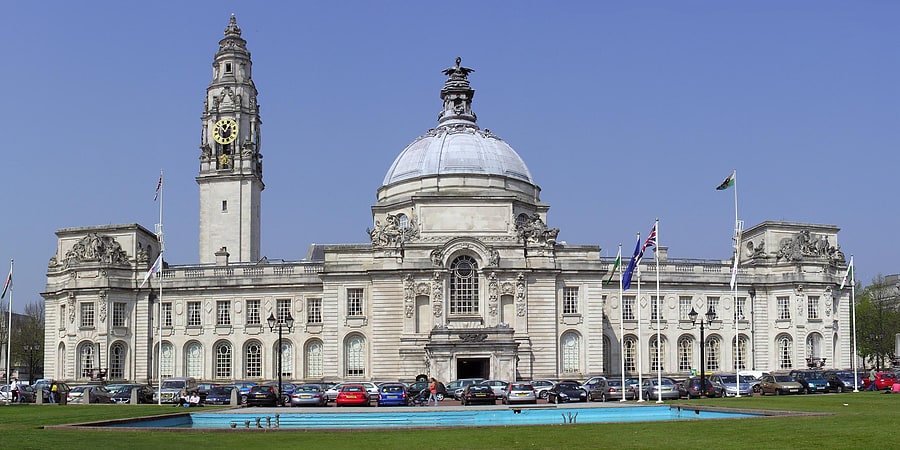
Building in Cardiff, Wales. City Hall is a civic building in Cathays Park, Cardiff, Wales, UK. It serves as Cardiff's centre of local government. It was built as part of the Cathays Park civic centre development and opened in October 1906. Built of Portland stone, it is an important early example of the Edwardian Baroque style. It is a Grade I listed building.[21]
Address: Cathays Park, CF10 3ND Cardiff (Canol Dinas Caerdydd)
Chapter Arts Centre

Art center in Cardiff, Wales. Chapter Arts Centre is an arts centre in Canton, Cardiff, Wales, opened in 1971.[22]
Address: Market Rd, CF5 1QE Cardiff (Gorllewin Caerdydd)
Cardiff International Arena

Exhibition centre in Cardiff, Wales. Cardiff International Arena is an indoor exhibition centre and events arena located in Cardiff, Wales, and was opened on 10 September 1993 by singer Shirley Bassey. Its current name is due to a five-year sponsorship agreement. It is Cardiff's largest purpose-built exhibition facility. The upstairs of the building is known as the World Trade Centre.[23]
Address: Cardiff, Mary Ann St, Cardiff CF10 2EQ Wales
South African War Memorial
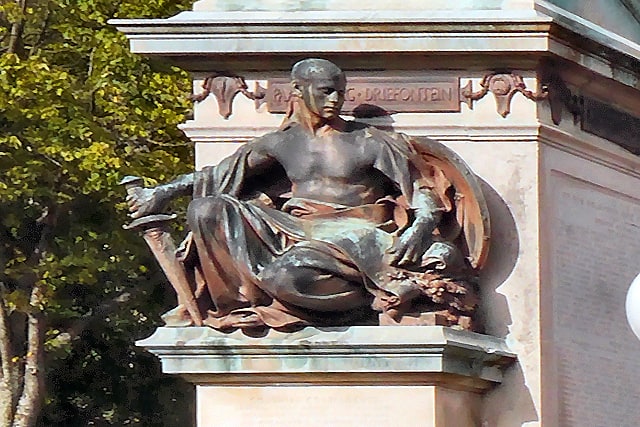
Historical landmark in Cardiff, Wales. The South African War Memorial, also known as the Boer War Memorial, is a war memorial in Cardiff, Wales. It was erected in 1908 and unveiled by General Sir John French on 20 November 1909 to honour the victims of the Second Boer War. It is a Grade II* listed structure.[24]
Dyffryn Gardens
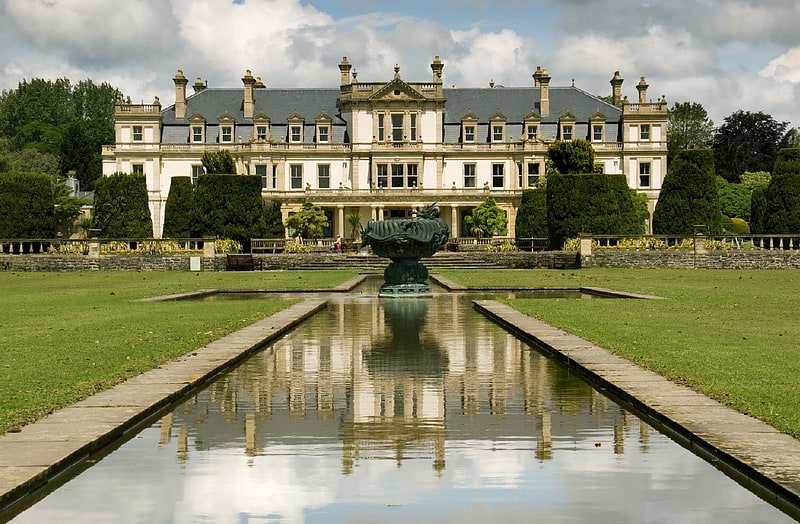
Garden in Wales. Dyffryn Gardens is a collection of botanical gardens located near the villages of Dyffryn and St. Nicholas in the Vale of Glamorgan, Wales. The gardens were selected by the British Tourist Authority as one of the Top 100 gardens in the UK and are in the care of the National Trust.[25]
Address: Dyffryn Ln, CF5 6SU Cardiff
Sophia Gardens

Stadium in Cardiff, Wales. The Cardiff Wales Stadium, which is part of Sophia Gardens Cardiff, is a cricket stadium in Cardiff, Wales. It is located in Sophia Gardens on the River Taff. It is home to Glamorgan County Cricket Club and is listed as an international Test cricket venue.[26]
Cosmeston Lakes Country Park
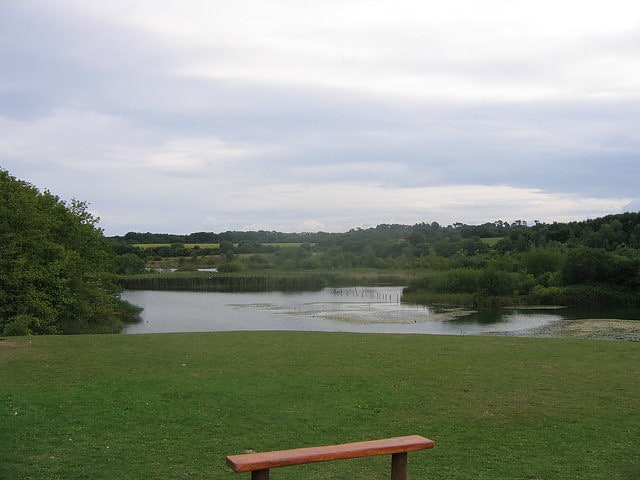
Country park in Wales. Cosmeston Lakes Country Park is a public country park in Great Britain, owned and managed by Vale of Glamorgan Council. It is situated between Penarth and Sully, Vale of Glamorgan, 7.3 miles from Cardiff. On 1 May 2013 the country park was designated a Local Nature Reserve LNR. Parts are Sites of Special Scientific Interest. The park, visitor centre and cafe are open all year round.[27]
Firing Line: Cardiff Castle Museum of the Welsh Soldier
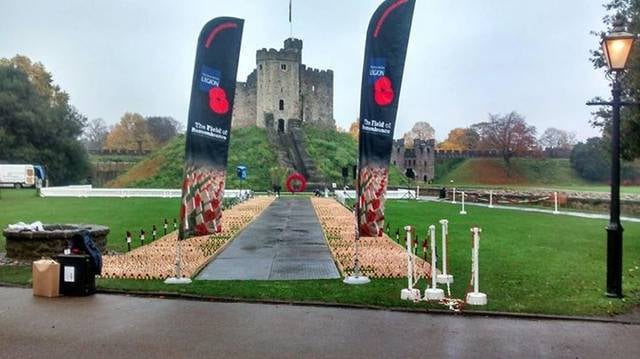
Museum in Cardiff, Wales. Firing Line: Cardiff Castle Museum of the Welsh Soldier is a museum which exhibits the collections of the 1st The Queen's Dragoon Guards and the Royal Welsh. It occupies the lower floor of the interpretation centre at Cardiff Castle.[28]
Address: Castle St, CF10 3RB Cardiff (Canol Dinas Caerdydd)
Techniquest
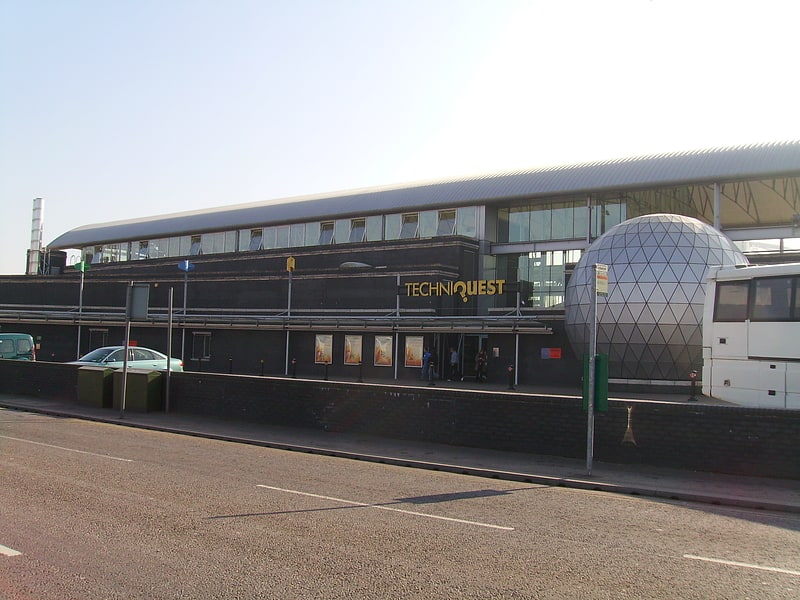
Science museum in Cardiff, Wales. Techniquest is a science discovery centre located in Cardiff Bay. It gives visitors a hands-on approach to science and includes a science theatre, a planetarium, and an exhibition space with over 100 interactive exhibits aimed at visitors of all ages.
Techniquest was founded in 1986 by Professor John Beetlestone (1932–2016) and his colleagues from Cardiff University. It previously had a sister venue located in Wrexham, along with locations in Llanberis in Gwynedd, and the Adventure Centre in Narberth, Pembrokeshire.[29]
Address: Stuart St, CF10 5BW Cardiff (Caerdydd Wouth)
Cardiff Arms Park
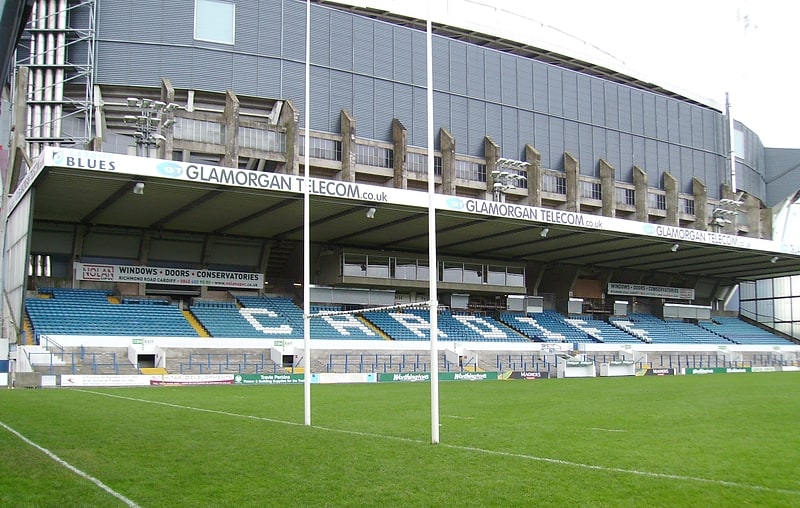
Stadium in Cardiff, Wales. Cardiff Arms Park, also known as The Arms Park, is situated in the centre of Cardiff, Wales. It is primarily known as a rugby union stadium, but it also has a bowling green. The Arms Park was host to the British Empire and Commonwealth Games in 1958, and hosted four games in the 1991 Rugby World Cup, including the third-place play-off. The Arms Park also hosted the inaugural Heineken Cup Final of 1995–96 and the following year in 1996–97.
The history of the rugby ground begins with the first stands appearing for spectators in the ground in 1881–1882. Originally the Arms Park had a cricket ground to the north and a rugby union stadium to the south. By 1969, the cricket ground had been demolished to make way for the present day rugby ground to the north and a second rugby stadium to the south, called the National Stadium. The National Stadium, which was used by Wales national rugby union team, was officially opened on 7 April 1984, however in 1997 it was demolished to make way for the Millennium Stadium in 1999, which hosted the 1999 Rugby World Cup and became the national stadium of Wales. The rugby ground has remained the home of the semi-professional Cardiff RFC yet the professional Cardiff Blues regional rugby union team moved to the Cardiff City Stadium in 2009, but returned three years later.
The site is owned by Cardiff Athletic Club and has been host to many sports, apart from rugby union and cricket; they include athletics, association football, greyhound racing, tennis, British baseball and boxing. The site also has a bowling green to the north of the rugby ground, which is used by Cardiff Athletic Bowls Club, which is the bowls section of the Cardiff Athletic Club. The National Stadium also hosted many music concerts including Michael Jackson, Dire Straits, David Bowie, Bon Jovi, The Rolling Stones and U2.[30]
Address: Westgate St., CF10 1JA Cardiff (Canol Dinas Caerdydd)
St Lythans burial chamber

Historical landmark in Wenvoe, Wales. The St Lythans burial chamber is a single stone megalithic dolmen, built around 4,000 BC as part of a chambered long barrow, during the mid Neolithic period, in what is now known as the Vale of Glamorgan, Wales.
It lies about half a mile (1 km) to the west of the hamlet of St Lythans, near Dyffryn Gardens. It also lies around one mile (1.6 km) south of Tinkinswood burial chamber, a more extensive cromlech that it may once have resembled, constructed during the same period.
The site is on pasture land, but pedestrian access is allowed and is free, with roadside parking available for 2–3 cars about 50 yards (50 metres) from the site.
The dolmen, which has never been fully excavated, is maintained by Cadw, the Welsh Historic Environment Agency.[31]
Cosmeston Medieval Village
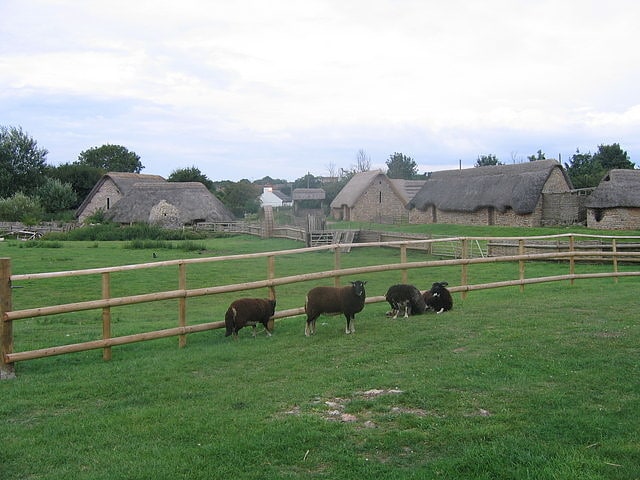
Village in Wales. Cosmeston Medieval Village is a living history medieval village near Lavernock in the Vale of Glamorgan, Wales. Based upon remains discovered during a 1980s archaeological dig in the grounds of Cosmeston Lakes Country Park, it is a re-creation of 14th century peasant life in Wales in the Late Middle Ages.
The reconstructed village regularly plays host to groups of reenactors, who camp in authentic tents around the outskirts of the village, and perform displays of historical combat for the public.[32]
Cardiff Story Museum
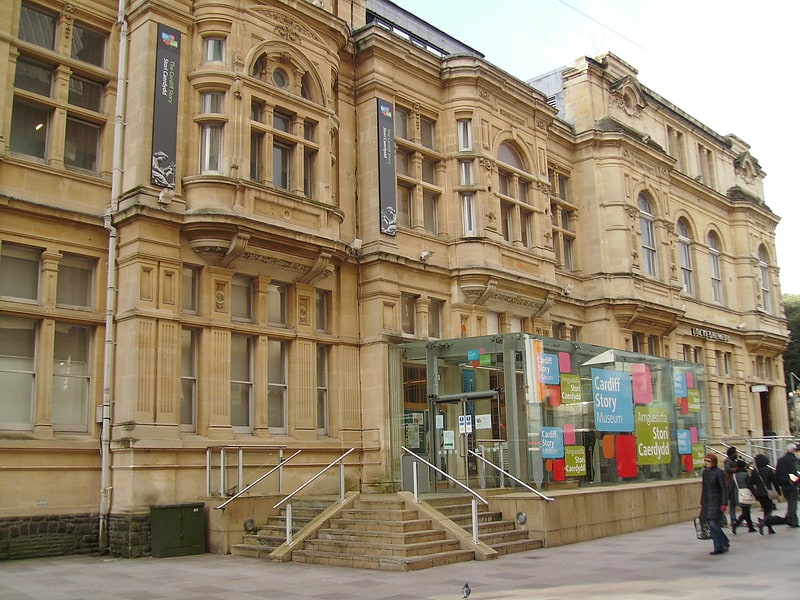
Museum in Cardiff, Wales. The Cardiff Story Museum is a museum in Cardiff, Wales which exhibits the history of the city. The museum opened on 1 April 2011 and entrance is free. The heritage museum has brought together a collection of 3,000 objects and Cardiff-related artefacts, many donated from Cardiff residents and communities.[33]
Address: The Hayes, CF10 1BH Cardiff (Canol Dinas Caerdydd)
St David's Hall
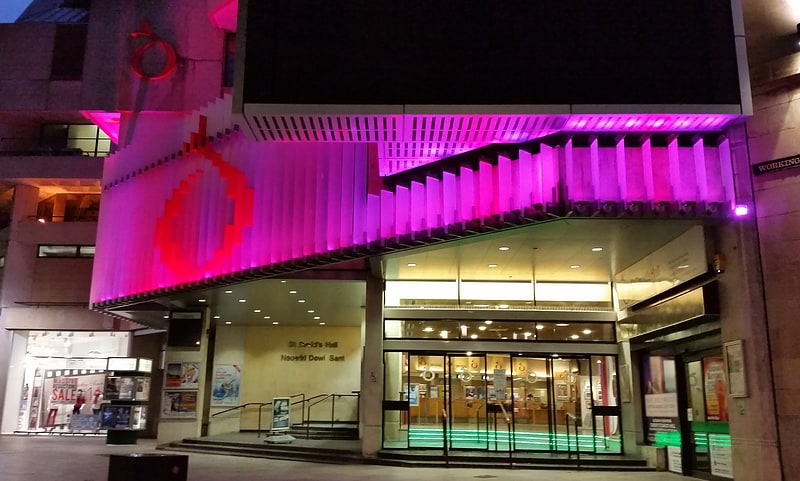
Conference centre in Cardiff, Wales. St David's Hall is a performing arts and conference venue in the heart of Cardiff, Wales.
St David's Hall is the National Concert Hall and Conference Centre of Wales. It hosts the annual Welsh Proms and the biennial BBC Cardiff Singer of the World competition. As well as classical music it also plays host to jazz, soul, pop, rock, dance, children's, rhythm and blues, musicals and other forms of world music, as well as light entertainment artists. The foyers in the centre are open and have regular free performances from music groups. The foyers, balconies and bar areas are also used to host art exhibitions.[34]
Address: Cardiff, The Hayes, Cardiff, CF10 1AH
New Theatre

Theatre in Cardiff, Wales. The New Theatre is one of the principal theatres of Cardiff, capital city of Wales. It is located in the city centre on Park Place, close to Cathays Park.
The theatre has a capacity of 1,144, and hosts a number of touring productions including musicals, plays and children's shows and also presents an annual Christmas pantomime.[35]
Address: Cardiff, Park Place